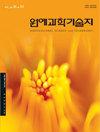花椒抗寒生理反应的比较模式
IF 0.8
4区 农林科学
Q3 HORTICULTURE
Korean Journal of Horticultural Science & Technology
Pub Date : 2023-10-31
DOI:10.7235/hort.20230044
引用次数: 0
摘要
辣椒(Zanthoxylum bungeanum Maxim)是一种具有重要营养价值和药用价值的经济作物,低温是影响其正常生长和品质的主要因素。测定其生理生化参数是辨别线索的关键,可以帮助农学家选择适宜的耐低温胁迫品种。本研究旨在研究不同品种黄姜的耐寒性,为黄姜提供最佳种植面积。在低温环境下对6个优良品种进行比较,采用隶属函数法对相关指标进行分析。结果表明,低温胁迫初期,超氧化物歧化酶(SOD)活性与丙二醛(MDA)含量呈极显著负相关(p < 0.01), SOD和过氧化物酶(POD)活性均呈升高趋势。低温胁迫时间越长,MDA和脯氨酸含量越高,叶绿素含量越低。Logistic模型表明,叶片电导率的低温半致死温度LT50在- 12.7°C ~ 1.2°C之间。通过隶属函数分析,对6个品种的耐寒能力进行了综合评价,并对其进行了排序:‘西农五次’和‘五次椒’为抗寒品种,‘少西大红袍’和‘黄盖’为中抗寒品种,‘狮子头’和‘葛老五次’为低温敏感品种。本研究为黄杨耐寒品种的选育和推广提供了必要的经验依据。本文章由计算机程序翻译,如有差异,请以英文原文为准。
Comparative Patterns of Physiological Responses to Cold Resistance of Zanthoxylum bungeanum Maxim
The pepper plant Zanthoxylum bungeanum Maxim (Z. bungeanum) is an economically important cash crop with both nutritional and medicinal value, but low-temperatures are a major factor affecting its normal growth and quality. Measuring its physiological and biochemical parameters is essential to distinguish clues that can help agriculturists select the proper types of Z. bungeanum with considerable tolerance to low-temperature stress. This study aims to investigate the cold tolerance of different Z. bungeanum types and provide the best cultivation area. Six excellent cultivars were compared in a low-temperature environment and the membership function method was used to analyze the relevant indicators. The results revealed a significant negative correlation between the superoxide dismutase (SOD) activity and malondialdehyde (MDA) content (p < 0.01), with both the SOD and peroxidase (POD) activity increasing during the early stages of exposure to low-temperature stress. The MDA and proline (Pro) contents increased with longer durations of low-temperature stress, whereas the chlorophyll (Chl) content decreased. Logistic modeling showed that the low-temperature semi-lethal temperature LT50 of leaf conductivity was from −12.7°C to 1.2°C. By means of a membership function analysis, the cold-tolerance abilities of the six cultivars of Z. bungeanum were comprehensively evaluated and were ranked as follows: ‘Xinongwuci’ and ‘Wucijiao’ are cold hardy, ‘Shaocidahongpao’ and ‘Huanggai’ are medium cold hardy, and ‘Shizitou’ and ‘Gelaowuci’ are low-temperature-sensitive cultivars. This study provides the necessary empirical basis for the selection and promotion of cold-resistant cultivars of Z. bungeanum.
求助全文
通过发布文献求助,成功后即可免费获取论文全文。
去求助
来源期刊
CiteScore
2.00
自引率
0.00%
发文量
0
审稿时长
1 months
期刊介绍:
Horticultural Science and Technology (abbr. Hortic. Sci. Technol., herein ‘HST’; ISSN, 1226-8763), one of the two official journals of the Korean Society for Horticultural Science (KSHS), was launched in 1998 to provides scientific and professional publication on technology and sciences of horticultural area. As an international journal, HST is published in English and Korean, bimonthly on the last day of even number months, and indexed in ‘SCIE’, ‘SCOPUS’ and ‘CABI’. The HST is devoted for the publication of technical and academic papers and review articles on such arears as cultivation physiology, protected horticulture, postharvest technology, genetics and breeding, tissue culture and biotechnology, and other related to vegetables, fruit, ornamental, and herbal plants.

 求助内容:
求助内容: 应助结果提醒方式:
应助结果提醒方式:


